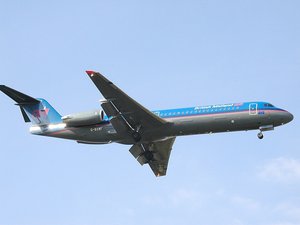Fokker F100
|
|
The Fokker F100 is a small twin-engine regional jet airliner and feederliner from the Fokker company. Low operational costs and almost no modern competition in the 100-seat short-range class made it a best seller when it was introduced in the late 1980s, but improved models of the Boeing 737 and Airbus A319 and 318 squeezed it into a niche and Fokker was soon insolvent. Production ended in 1997 with 283 airframes delivered.
The F100 design was announced in 1983 as an updated replacement for their popular, but outdated, Fokker F28 Fellowship design. The most noticeable difference is the much longer fuselage, which almost doubled the seating from 65 in the original F28 series to 107 in a three-by-two single-class arrangement. Fokker also introduced a redesigned wing for the F100, which they claimed was 30% more efficient in cruise. The engines were upgraded to the modern Rolls-Royce Tay turbofans, while the cockpit was updated with an all-glass instrumentation package.
Two prototypes were built. The first, PH-MKH, flew for the first time on November 30, 1986, and the second, PH-MKC, followed on February 25, 1987. The type certificate was awarded in November 1987. Testing went smoothly and the first deliveries of the Tay 650-15 powered versions started to Swissair in February 1988.
By 1991, Fokker had already produced 70 units and had orders for a total of more than 230. An extended range version with additional fuel tanks in the wings was introduced in 1993, and a quick-change passenger/freighter version in 1994, the F100QC. A shorter version was introduced in 1993 as a direct replacement for the earlier F27, known as the Fokker 70, which removed 4.70 m of the fuselage and reduced seating to 80. Studies on the 130 seat F130 and Fokker Executive Jet 100 were never followed up on.
Although the design was a success in the marketplace, Fokker continued to lose massive amounts of money producing it. Eventually their parent company, Daimler Benz Aerospace, gave up and shut them down. Fokker collapsed financially in 1996, and wound up production in early 1997. There had been some dicussion about the company being purchased by Bombardier, but the plans fell through. This is particularly ironic given that Bombardier is currently scrambling to produce a new 130 seat design to compete with Embraer's latest aircraft (in 2004).
An Amsterdam-based group, Rekkof Restart (Fokker spelled backwards) started negotiating to re-open the Fokker 70 and F100 lines in 1999, but the deal never completed. But there are still talking about the possibility to re-open the Fokker 70 production line. Like any number of designs, the F70/F100 was being increasingly squeezed from below by stretched versions of the Bombardier and Embraer regional jets, which also killed off plans for the Fairchild JET and an unnamed design from ATR.See also:List of civil aircraft
Specifications
General characteristics
- Wing span: 28.8 m
- Length: 35.3 m
- Height: 8.6 m
- Gross weight: 44.5 tonnes
- Engines: 2x Rolls-Royce Tay Mk. 650-15, 15,100 lbf (67 kN) thrust
- Passenger capacity: 85 to 122, 107 typical
- Crew: 2 flight crew, 2 to 3 cabin crew
Performance
- Cruising speed: 755 km/h (845 km/h high-speed cruise)
- Range: 4,300 km (4,750 km in the ER versions)
|
Lists of Aircraft | Aircraft manufacturers | Aircraft engines | Aircraft engine manufacturers Airports | Airlines | Air forces | Aircraft weapons | Missiles | Timeline of aviation |

